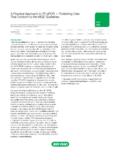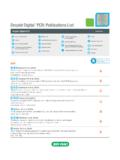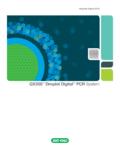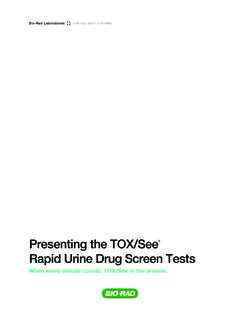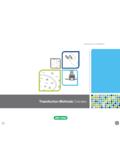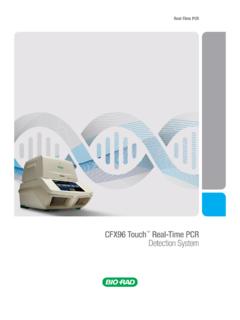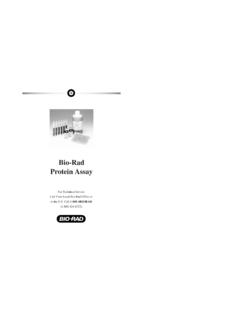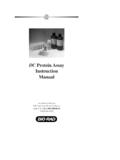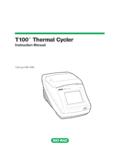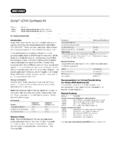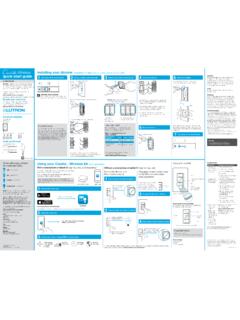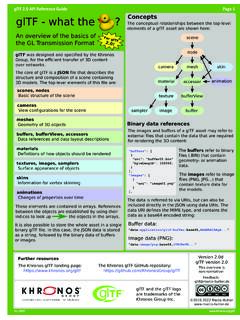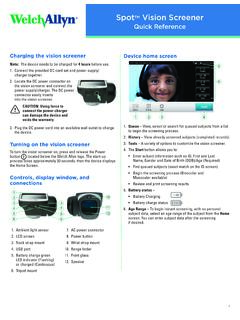Transcription of Quick Start Bradford Protein Assay - Bio-Rad Laboratories
1 Quick Start BradfordProtein AssayInstruction ManualFor technical service call your local Bio-Rad office, or in the US,1-800-4 BIORAD (1-800-424-6723) 9/25/2007 2:39 PM Page 1 Table of ContentsSection 1 Selecting a Protein Product Description9 Section 2 Standard Assay Microassay Protocol14 Section 3 Data Analysis18 Section 4 FAQs and Troubleshooting22 Section 5 Ordering Information26 Section 6 References28 Section 7 9/25/2007 2:39 PM Page 5 Section 1 IntroductionThe Quick Start Bradford Protein Assay is a simple and accurate procedure for determiningthe concentration of Protein in solution.
2 It providesready-to-use convenience by supplying the dyereagent at 1x concentration and two Protein assaystandards at seven prediluted concentrations. Theprediluted standards are conveniently packaged in2 ml screwcap vials, eliminating wasteful andsharp ampoules, and ensuring Protein stabilityover the shelf life of the PrincipleThe Bradford Assay is a Protein determinationmethod that involves the binding of 9/25/2007 2:39 PM Page 7 Brilliant Blue G-250 dye to proteins (Bradford1976). The dye exists in three forms: cationic(red), neutral (green), and anionic (blue) (Comptonand Jones 1985).
3 Under acidic conditions, thedye is predominantly in the doubly protonated redcationic form (Amax= 470 nm). However, when thedye binds to Protein , it is converted to a stableunprotonated blue form (Amax= 595 nm) (Reisneret al. 1975, Fazekes de St. Groth et al. 1963,Sedmack and Grossberg 1977). It is this blue Protein -dye form that is detected at 595 nm in theassay using a spectrophotometer or microplatereader. H+H+Cation Neutral form Anion470 nm (red)650 nm (green) 595 nm (blue) 9/25/2007 2:39 PM Page 8 Work with synthetic polyamino acids indicatesthat Coomassie Brilliant Blue G-250 dye binds primarily to basic (especially arginine) and aromatic amino acid residues (Compton andJones 1985).
4 Spector (1978) found that theextinction coefficient of a dye-albumin complexsolution was constant over a 10-fold concentra-tion range. Thus, Beer's law may be applied foraccurate quantitation of Protein by selecting anappropriate ratio of dye volume to sample chemical- Protein and chemical-dye interactions interfere with the Assay . Interferencefrom non- Protein compounds is due to their abilityto shift the equilibrium levels of the dye among thethree colored species. Known sources of interference, 9/25/2007 2:39 PM Page 9such as some detergents, flavonoids, and basicprotein buffers, stabilize the green neutral dyespecies by direct binding or by shifting the pH(Compton and Jones 1985, Fanger 1987).
5 Nevertheless, many chemical reagents do notdirectly affect the development of dye color whenused in the standard protocol and the more common reagents are listed in Table 1. Themicroassay is compatible with lower concentra-tions of reagents 1/25than listed in Table 1 due tothe larger sample volume-to-dye ratio. Since everyprotein-chemical reagent combination has notbeen assayed, it is possible that some of the list-ed reagents interfere in combination with certainproteins. However, with respect to proteins suchas bovine serum albumin (BSA) and 9/25/2007 2:39 PM Page 10gamma--globulin, the listed reagents show little orno interference.
6 Selecting a Protein StandardIn any Protein Assay , the ideal Protein to use as astandard is a purified preparation of the proteinbeing assayed. In the absence of such anabsolute reference Protein , another Protein mustbe selected as a relative standard. The best relative standard to use is one that gives a coloryield similar to that of the Protein being such a Protein standard is generallydone empirically. Alternatively, if only relative Protein values are desired, any purified proteinmay be selected as a standard. The two mostcommon Protein standards used for proteinassays are BSA and 9/25/2007 2:39 PM Page 11 With the Quick Start Bradford Protein Assay , dyecolor development is significantly greater withBSA than with most other proteins, including gamma--globulin.
7 Therefore, the BSA standardwould be an appropriate standard if the samplecontains primarily albumin, or if the Protein beingassayed gives similar response to the dye. For acolor response that is typical of many proteins,the gamma--globulin standard is 9/25/2007 2:39 PM Page 12 Table 1. Reagents compatible with theQuick Start Bradford Protein Assay whenusing the standard procedure.*7 Acetone, 10%Acetonitrile, 10%Ammonium sulfate, 1 MAmpholytes, 3 10, , acid, 50 mMBis-Tris, pH , Mb-mercaptoethanol, 1 MCalcium chloride, 40 mMCHAPS, 10%CHAPSO, 10%Deoxycholic acid, , 5%Dithioerythritol (DTE), 10 mMDithiothreitol (DTT)
8 , 10 mMEagle's MEME arle's salt solutionEDTA, M EGTA, MEthanol, 10%Glucose, 20%Glycerol, 5%Glycine, MGuanidine-HCl, 2 MHank's salt solutionHCl, MHEPES, MImidazole, MMagnesium chloride, 1 MMES, MMethanol, 10%Modified Dulbecco's PBSMOPS, MNAD, 2 mMNonidet P-40, b-glucoside, b-thioglucopyranoside, 1%PBS 9/25/2007 2:39 PM Page 13 Coomassie is a trademark of Imperial Chemical Industries. Triton is a trademarkof Union Carbide Corp. Tween is a trademark of ICI Americas, Inc. *The concentration limits for compatibility with the microassay are 1/25of thevalues in Table , 5 mMTBS (25 mM Tris, M NaCl,pH ), TCEP, 20 mM Thio-urea, 1 MTricine, pH 8, 50 mMTriethanolamine, pH , 50 mMTris, 1 MTris-glycine (25 mM Tris, 192 mMglycine)Tris-glycine-SDS, (25 mM Tris,192 mM glycine, SDS)
9 , X-100, Tween 20, , 4 MPhenol Red, mg/mlPIPES, MPMSF, 2 mMPotassium chloride, 2 MPotassium phosphate, MSB 3 10, , acetate, pH , MSodium azide, bicarbonate, MSodium carbonate, MSodium chloride, MSodium citrate, pH or , MSodium hydroxide, MSodium phosphate, MSucrose, 10% 9/25/2007 2:39 PM Page Product DescriptionAll kit components have a 1 year shelf life at 4 are provided in a NaCl, 1x Dye Reagent:1 L of dye solution containingmethanol and phosphoric acid. One bottle of dyereagent is sufficient for 200 assays using the standard 5 ml procedure or 4,000 assays usingthe microplate procedure.
10 BSA Standard, 2 mg/ml:Provided in 2 Gamma-Globulin Standard, 2 mg/ml:Provided in 2 ml 9/25/2007 2:39 PM Page 15 Bovine Serum Albumin Standard Set:Set of 7 concentrations of BSA (2, , 1, , , , mg/ml) in 2 ml Gamma-Globulin Standard Set:Set of 7 concentrations of gamma--globulin (2, , 1, , , , mg/ml) in 2 9/25/2007 2:39 PM Page 16 Section Standard Protocol standard protocol can be performed inthree different formats, 5 ml and a 1 mlcuvette Assay , and a 250 l microplate linear range of these assays for BSA is125 1,000 g/ml, whereas with gamma-globulin the linear range is 125 1,500 g/ml.
